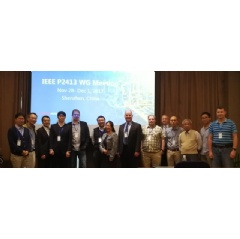Huawei’s Proposed Smart City Structure Agreed for P2413 Standard at IEEE P2413 IoT Work Group Meeting
Huawei has successfully submitted standards proposals for the evolving Internet of Things, at the meeting of the IEEE P2413 (Standard for An Architectural Framework for the Internet of Things) Work Group, held in Shenzhen Nov 28 – Dec 1, 2017. Huawei submitted a proposal that encompassed Device Management, Connection Management, Application Enablement of IoT Platforms and Big Data Analysis. After online and offline discussion, the meeting delegates agreed to add Huawei’s proposed text into the P2413 standard.
Delegates at the meeting represented Huawei, IoTecha, Schneider Electric, Siemens, Kaspersky, Deutsche Telekom, Hitachi, and the IEEE. The meeting reviewed input from two of the IEEE P2413 partner standardization organizations, IEEE P42010 (Systems and software engineering – Architecture description) and IVI (Industrial Value Chain Initiative). Nearly 100 comments were carefully considered, providing an opportunity to enhance the next version of the IEEE P2413 Draft Standard.
The meeting was an example of global industry collaboration as the key to the successful development and widespread adoption of the Internet of Things (IoT). A proposed OPC-UA framework document, based on the P2413 Architectural Framework principle, was also agreed in the meeting and will be added as an example of P2413. Huawei and Deutsche Telekom will then jointly submit a similar document to describe the framework of oneM2M based on the P2413 principle. Additional comments from organizations like the Industrial Internet Consortium (IIC) are also expected in the near future.
Mr. Joe So, CTO of Huawei EGB Industrial Solutions, welcomed participants with the meeting’s opening speech. “Huawei believes that to protect our customers’ investments, it is our obligation to participate in standards bodies like the IEEE P2413,” So explained. “We need to maintain our technology leadership and protect our customers’ interests through development of open standards enabling global ecosystems.”
“The IEEE P2413 Standard for an Architectural Framework for the Internet of Things will be one of the key factors driving the success of Smart City development. It will help Smart Cities become Smarter and Safer and enhance the livelihood of citizens, improve government capabilities in city management, and deliver on the promise of digital transformation,” So said.
IEEE P2413 chairman, Oleg Logvinov, said, “The words spoken by Mr. Joe So during his welcome address to the IEEE P2413 is the best evidence of the importance of the work done by this Working Group. Development of Smart Cities, as well as edge computing and its relevant enabling technologies, is not possible without IoT and strong technical leadership. Huawei is one of the founding members of the IEEE P2413 and Huawei’s contributions have significantly enhanced the current body of work, especially addressing the important topics of IoT in Smart Cities and edge computing. It is also important to highlight Huawei’s continuing leadership in this working group. Huawei has taken the important role of editor of the Draft Standard.”
Smart City is ultimately about solving real-world problems. The early Smart City efforts focused on dealing with administrative data and Internet data. These are like rivers and oceans, but the data generated from the Internet of Things, is like galaxies and stars. And to solve real-world issues in living cities, we have to deal with all of them: IoT, administrative and Internet data.
Huawei is one of the few ICT solution providers in the industry that can offer end-to-end cloud-pipe-device solutions, leading the way to connecting the physical and digital worlds. We will continue to work together with our ecosystem of partners to create top-level designs addressing city administrators’ needs and achieving the ultimate goals of a Smart City – to enable good governance, promote industry development and deliver benefits for the people.
The IEEE P2413 was initiated by the IEEE in 2014. The IoT is predicted to become one of the most significant drivers of growth in various technology markets. Most current standardization activities are confined to specific verticals and represent islands of disjointed and often redundant development. The architectural framework defined in this standard will promote cross-domain interaction, aid system interoperability and functional compatibility, and further fuel the growth of the IoT market. The adoption of a unified approach to development of IoT systems will reduce industry fragmentation and create a critical mass of multi-stakeholder activities around the world.
The participants of the IEEE P2413 meeting also had an opportunity to visit the Huawei industrial exhibition center at Huawei’s headquarters in Shenzhen. The delegates had an opportunity to see a broad range of vertical industrial solutions, such as Smart Cities, Safe Cities, Smart Government, Smart Education, Smart Transportation, Smart Energy, Smart Finance, Smart Manufacturing and Media, and more.
( Press Release Image: https://photos.webwire.com/prmedia/6/217383/217383-1.jpg )
WebWireID217383
This news content was configured by WebWire editorial staff. Linking is permitted.
News Release Distribution and Press Release Distribution Services Provided by WebWire.
